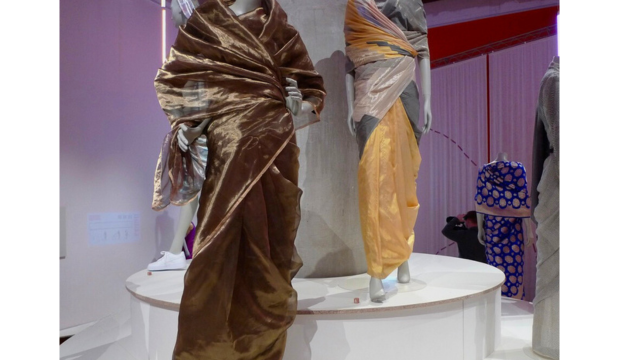The Offbeat Sari, Design Museum review ★★★★★
The Design Museum's sari exhibition featuring 90 contemporary pieces, illuminates how the iconic garment is worn
The Offbeat Sari, Design Museum exhibition. Saris: Bodice and Abraham & Thakore, _
When the Head of Curatorial at the Design Museum Priya Khanchandani moved temporarily to India a few years ago, she was amazed by the way Delhi women wore their saris. She realised that what used to be seen as an old fashioned costume had become a way to express one's identity. The sari had become 'cool', and fashion designers and people on the streets were reinventing the way to wear it, not afraid of pushing the boundaries.
The Offbeat Sari exhibition, curated by Khanchandani herself, focuses on this reinvention and reveals a fascinating side of contemporary Indian fashion.
The show brings together over 90 examples of saris made over the past decade, nearly all of which are on loan from designers and studios across India and have never been seen in Britain. It is, in short, a feast for the eyes.
Conventionally a single piece of unstitched fabric, the sari is inherently fluid. Adapted in drape and form over millennia, it reflects identity, social class, taste and function across time and geography, and remains an enduring part of life in India today. Yet in recent decades, for many, the sari has been considered traditional, or uncomfortable, as a form of everyday clothing, especially by young people.
This vision is precisely what contemporary designers, from growing global brands to emerging studios, are challenging.
Sumptuous items from Raw Mango, Akaaro and NorBlackNorWhite are a great example of this dynamic shift. The use of pioneering material, the revisiting of the traditional drape, or the pairing with contemporary accessories: all bring modern relevance to the traditional outfit.

Akaaro's handwoven saris are made from copper and steel
With the Gen Z audience in mind, NorBlackNorWhite – whose designers moved from their home in Toronto to Mumbai to explore their Indian roots – infuses Y2K urban aesthetic into a colourful cotton lurex sari styled with Nike trainers.

NorBlackNorWhite sari cotton and lurex sari
Meanwhile, anyone looking for a party dress will be dazzled by the otherworldly selection of evening saris and 'sari-dresses' – a new concept of saris redesigned into dresses – on display.
Akaaro's handwoven's dazzling saris made of steel and copper rival Manish Malholra's extravagant Bollywood-style sequin number.

Black Sari by Huemn, sari dress and distressed denim sari by Diksha Khanna
One of the exhibition highlights is the first-ever sari worn at the Met Gala in 2022. Designed by Sabyasachi, and styled with a gold Schiaparelli bodice, the ensemble was worn by Indian businesswoman and socialite Natasha Poornawalla and caught attention for its dramatic mix of Indian and Western couture.

Rimizim Dadu, Gold Sculpted Wave Steel Sari
The Offbeat Sari exhibition, curated by Khanchandani herself, focuses on this reinvention and reveals a fascinating side of contemporary Indian fashion.
The show brings together over 90 examples of saris made over the past decade, nearly all of which are on loan from designers and studios across India and have never been seen in Britain. It is, in short, a feast for the eyes.
Conventionally a single piece of unstitched fabric, the sari is inherently fluid. Adapted in drape and form over millennia, it reflects identity, social class, taste and function across time and geography, and remains an enduring part of life in India today. Yet in recent decades, for many, the sari has been considered traditional, or uncomfortable, as a form of everyday clothing, especially by young people.
This vision is precisely what contemporary designers, from growing global brands to emerging studios, are challenging.
Sumptuous items from Raw Mango, Akaaro and NorBlackNorWhite are a great example of this dynamic shift. The use of pioneering material, the revisiting of the traditional drape, or the pairing with contemporary accessories: all bring modern relevance to the traditional outfit.

Akaaro's handwoven saris are made from copper and steel
With the Gen Z audience in mind, NorBlackNorWhite – whose designers moved from their home in Toronto to Mumbai to explore their Indian roots – infuses Y2K urban aesthetic into a colourful cotton lurex sari styled with Nike trainers.

NorBlackNorWhite sari cotton and lurex sari
Meanwhile, anyone looking for a party dress will be dazzled by the otherworldly selection of evening saris and 'sari-dresses' – a new concept of saris redesigned into dresses – on display.
Akaaro's handwoven's dazzling saris made of steel and copper rival Manish Malholra's extravagant Bollywood-style sequin number.

Black Sari by Huemn, sari dress and distressed denim sari by Diksha Khanna
One of the exhibition highlights is the first-ever sari worn at the Met Gala in 2022. Designed by Sabyasachi, and styled with a gold Schiaparelli bodice, the ensemble was worn by Indian businesswoman and socialite Natasha Poornawalla and caught attention for its dramatic mix of Indian and Western couture.

Rimizim Dadu, Gold Sculpted Wave Steel Sari
TRY CULTURE WHISPER
Receive free tickets & insider tips to unlock the best of London — direct to your inbox
| What | The Offbeat Sari, Design Museum review |
| Where | Design Museum, 224-238 Kensington High Street, Kensington, London, W8 6AG | MAP |
| Nearest tube | High Street Kensington (underground) |
| When |
19 May 23 – 17 Sep 23, 10:00 AM – 6:00 PM |
| Price | ££12.60 |
| Website | https://designmuseum.org/exhibitions/the-offbeat-sari# |